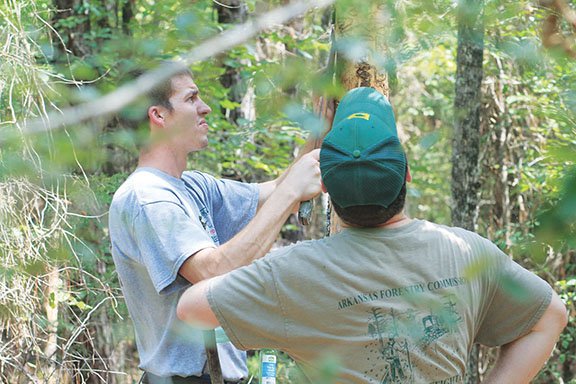The city of Prairie Village, Kansas, has always been known for its thousands of trees. The community of 22,000 has had the distinction of being a Tree City USA designation, but the city will soon chop down as many as 700 ash trees to prevent the spread of the emerald ash borer.
“We are starting with the trees in the worst condition and smaller trees so the replacement trees will fill in the space better,” said Keith Bredehoeft, director of public works in Prairie Village. “Once a tree dies, its branches become brittle and have a tendency to fall.”
The ash borer, accidentally imported in Michigan from Asia in 2002, has killed tens of millions of trees in 27 states and Canada and has now been found in six Arkansas counties: Clark, Hot Spring, Columbia, Dallas, Nevada and Ouachita.
The Arkansas State Plant Board is proposing a quarantine on the movement of firewood, ash nursery stock and ash logs, sawed logs, pulpwood, mulch and compost in these six counties and 19 other surrounding counties to slow the spread of the ash borer. The border counties include Garland, Grant and Saline.
A task force with members from the Arkansas State Plant Board, the Arkansas Forestry Commission, the University of Arkansas Cooperative Extension Service, the Arkansas Forestry Association, Arkansas State Parks, the U.S. Army Corps of Engineers, the Arkansas Association of Conservation Districts, and the Natural Resources Conservation Service and the U.S. Department of Agriculture met Monday to discuss a possible quarantine.
A decision on the proposed quarantine could be made Sept. 11 by the Arkansas State Plant Board. One option is to enact an emergency rule that would establish a quarantine for 120 days. This would allow the organization to hold public hearings on the issue.
State Forester Joe Fox, director of the Arkansas Forestry Commission, was asked if the quarantine would end the threat of the emerald ash borer.
“The blunt answer is no,” Fox said. “It would slow down the spread and allow timber owners to claim the value of their wood, tell people what’s coming and have a plan of what do to.”
Fox said experts do not know how the climate will affect the insect. In Canada, the life cycle of the borer can take as long as two years.
“With our warm weather, it could have two life cycles a year in South Arkansas,” Fox said. “That could be a nightmare.”
According to the Forestry Commission, less than 2 percent of the merchantable trees in Arkansas are ash.
“Less than 2 percent is not as prevalent for the market, but it is still a valuable tree,” said Adriane Barnes, spokeswoman for AFC. In each of the past five years, more than 9 million board feet of ash has been harvested in Arkansas.”
Fox said that while he has seen trees killed by the borer in Arkansas that would have a total value of only about $1,000, the potential loss is huge.
If a homeowner has a favorite ash tree in the yard, Fox said, there are ways to keep it safe from the ash borer.
“The tree can be treated with a variety of sprays and injections. They will kill any borer that infests the tree or keep them away,” Fox said, “but that is not an effective or efficient way to treat trees in the woods or an entire forest of ash trees.”
Barnes said a quarantine would slow the movement of the emerald ash borer.
“It is certain the EAB travels through people moving firewood long distances as we hunt, fish, camp and generally enjoy the outdoors, along with moving pulpwood and logs for manufacturing purposes,” she said. “The quarantine addresses the most certain process we know that spreads the EAB.”
So far, insect traps and timber inspections by foresters have led to the confirmation of sites where the ash borer has attacked trees. The plant board, along with its partners from other agencies, will oversee the distribution of insect traps inside and outside of the quarantine areas.
Already, hunters and campers
are being asked to use all firewood within 25 miles of its origin.
Jon Barry, an assistant professor of forestry at the extension service’s Research and Extension Center in Hope, said it took some time to figure out how the borer came to Arkansas.
“I should have realized it soon,” he said. “I have lived in south Arkansas all my life, and I remember what I would see the day before deer season — one camper-trailer after another of out-of-state hunters coming in, many of them carrying what they would need in the woods, including firewood.”
The Arkansas State Plant Board will make a final decision on the quarantine and the rules under which it will operate. The board will be the lead agency in the partnership of natural-resource, tourism and timber interests.
“It is a large partnership working on the problems,” said Fox of the AFC. “Meanwhile, we will educate landowners, homeowners and visitors not to move wood long distances.”
Staff writer Wayne Bryan can be reached at (501) 244-4460 or wbryan@arkansasonline.com.
